How to Successfully Mix Wood Tones in Your Home

When it comes to interior design, incorporating different wood tones can add warmth, depth, and visual interest to your home. However we understand, mixing wood tones can be a challenging task. If not done correctly, it can result in a chaotic and mismatched look. But with a few simple tips, you can successfully mix wood tones in your home and create a harmonious and visually appealing environment.

Follow these four tips to help you successfully mix wood tones in your home today.
1. Mix it up.

Don't use the same wood tone through out your entire space. By doing so you will make your room feel flat and uninviting. Gone are the days of matching every piece of furniture and trim with the same tone.
Instead, embrace the beauty of different wood tones. This will create a more visually interesting and inviting space.
2. Choose a primary and secondary tone.

Your Primary wood tones refer to the dominant wood color or finish in a room. This is usually the color of the most prominent wood element in the space such a wooden floors, kitchen cabinets, or trim and doors.
Having a primary wood tone provides a sense of cohesion and grounding in a room. It helps to establish a visual anchor and creates a focal point.
Your secondary wood tone is a complementary color that helps to enhance and balance the primary wood tone. It can be introduced through smaller furniture pieces (like our wooden benches) and accessories (Our wooden trays are a wonderful small accessories).
Secondary wood tones add depth and dimension to your room. They help to break up the monotony of a single wood tone and create visual interest. By introducing secondary wood tones, you will create a more layered and curated look.
3. Understand the undertone
When mixing wood tones, it's important to pay attention to the undertones of each type of wood.
Some woods have warm undertones, like red, yellow, or orange while others have cool undertones, like gray, green, or blue. To ensure a cohesive look, match the undertones of the different wood tones in your space. This will help create a sense of harmony and prevent clashing colors.

4. Use each tone more than once in your space

In order to design a cohesive space spread each wood tone all through out the room.

By using each wood tone multiple times through out your space it will help you create a harmonious flow through out the room and establish a visual connection between different areas of the space. This repetition creates a sense of unity and cohesiveness, making the room feel well put together.
By following these four expert tips, you can successfully mix wood tones in your home and create a visually stunning and cohesive space. Remember to start by choosing a couple different tones, starting with a dominant tone and then adding a contrasting tone ,understand the undertone in the wood/stain that you are using, and use each tone more than once. With these guidelines in mind, you can achieve a harmonious and balanced look that will elevate the style of your home.

Leave a comment